Notes: Upton Magna station was situated on the Shrewsbury & Wellington Railway (S&W), a joint line of 10 miles that was authorised on 3 August 1846. The S&W partners were the Shrewsbury & Birmingham Railway (S&B) and the Shropshire Union Railways & Canal Company (SUR&CC). For the S&B the joint line provided a link to Shrewsbury for its Wolverhampton line and for the SUR&CC for its Stafford line. The S&W opened on 1 June 1849 as did the SUC&RC Stafford and Wellington line which was immediately leased to the London & North Western Railway (LNWR). The S&B opened from Wellington to Oakengates at the same time but it did not reach Wolverhampton until 12 November 1849.
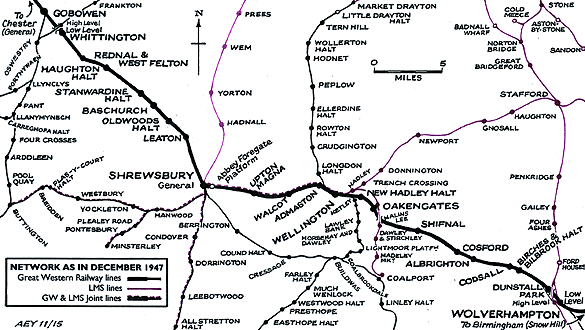 |
The station was located south of the village of Upton Magna just over 3 miles from Shrewsbury. It was on the east side of Pelham Lane which passed over the line on a bridge. The main facilities were on the up platform (Wolverhampton direction). The two-storey building was of brick with roofs of shallow pitch aligned parallel to the platform and towards the forecourt. Two gabled attics faced the platform. A flat awning extended the full length of the building, fronted by a shallow serrated valance, but the underside of the awning had a distinctive concave curve. A single-storey wing with an extremely tall chimneystack extended west of the main two-storey structure.
At the time of opening there would not have been any platforms and no facilities were provided on the down side (Shrewsbury direction).
Goods sidings were provided east of the station on the north side of the line.
Upton Magna opened with the line on 1 June 1849. The March 1850 timetable showed nine up and ten down trains on Monday-to-Saturday as seen in the table below. On Sunday there were four trains each way. Two of the up trains travelled to Stafford and two to Wolverhampton. The down trains all went to Shrewsbury, two being LNWR services from Stafford and two S&B services from Wolverhampton.
Up Trains March 1850 |
Destination |
Down Trains March 1850 |
Destination |
6.10am (LNWR train) |
Stafford |
8.25am (S&B train) |
Shrewsbury |
8.10am (S&B train) |
Wolverhampton |
9.58am (LNWR train) |
Shrewsbury |
9.56am (LNWR train) |
Stafford |
11.35am (S&B train) |
Shrewsbury |
10.20am (S&B train) |
Wolverhampton |
1.38pm (LNWR train) |
Shrewsbury |
12.48pm (S&B train) |
Wolverhampton |
1.55pm (S&B train) |
Shrewsbury |
3.55pm (S&B train) |
Wolverhampton |
3.55pm (S&B train) |
Shrewsbury |
5.30pm (LNWR train) |
Stafford |
6.25pm (S&B train) |
Shrewsbury |
7.05pm (LNWR train) |
Stafford |
7.47pm (LNWR train) |
Shrewsbury |
7.40pm (S&B train) |
Wolverhampton |
8.50pm (S&B train) |
Shrewsbury |
|
|
10.21pm (LNWR train) |
Shrewsbury |
The S&B had close ties with the Shrewsbury & Chester Railway (S&C) and together the companies had aspirations to create an alternative route between the Midlands and the River Mersey. These intentions antagonised the LNWR who worked tirelessly to frustrate them. One of the ways in which the LNWR caused trouble for the S&B was stopping it from reaching Birmingham. Despite having Birmingham in its name the company was never able to gain access to the town over its own metals.
The Great Western Railway (GWR) also aspired to reach the River Mersey and it had the size and corporate muscle to take on the LNWR. This led to the S&B and the S&C becoming part of the GWR on 1 September 1854; the S&W became a joint line of the LNWR/GWR. The GWR had reached Wolverhampton in April 1854. A mixed gauge line (broad gauge at 7ft 0¼in and 4ft 8½in standard gauge) line was opened between Wolverhampton and Birmingham on 13 November 1854. This created the through route between Shrewsbury and Birmingham that the S&B had desired and a line between London Paddington and the River Mersey at Birkenhead that the LNWR had done everything in its power to stop.
.gif) A few trains from Upton Magna had started to run through to Birmingham New Street on 4 February 1854 via an LNWR line but they moved to Birmingham Snow Hill on 13 November 1854 and the service was improved. A few trains from Upton Magna had started to run through to Birmingham New Street on 4 February 1854 via an LNWR line but they moved to Birmingham Snow Hill on 13 November 1854 and the service was improved.
Under the GWR the line through Upton Magna became a busy trunk railway that carried express and local passenger trains and large volumes of freight. A Birmingham – Birkenhead express service was introduced on 1 May 1857 and a London Paddington – Birkenhead service on 1 October 1861. These were prestigious trains that called only at principal stations.
At some point in the second half of the nineteenth century platforms were added to Upton Magna station. They extended under the bridge to the western side. A timber waiting room was provided on the down platform.
In 1895 there were eight up and six down trains Monday-to-Friday. Five of the up trains were GWR services. Two ran to Wolverhampton Low Level, one went to Wellington, one to Birmingham Snow Hill and one went to the South West. Three of the up services were LNWR trains that travelled to Stafford. Four of the down trains were GWR services two going to Chester and two to Shrewsbury. The other two down services were LNWR trains that travelled to Shrewsbury having originated at Stafford. On Saturdays there was an extra train in each direction running between Shrewsbury and Wellington. There were four trains each way on Sundays of which one in each direction was an LNWR service.
By this time a goods loop had been installed on the down side of the line to the east of the station. A signal box, also on the down side, had also been provided to control the loop and access to the goods yard. The box was located east of the station at the western end of the goods loop.
In 1903 12,757 passenger tickets were sold at Upton Magna and 3,314 parcels were handled. The goods sidings received 208 tons of general goods and forwarded 248. Seventeen trucks of livestock were also handled and deliveries of coal amounting to 21 tons were received.
In 1909 the goods loop was extended westwards. It ran behind the down platform and passed under the bridge re-joining the down main line to the west of the station.
On 1 January 1923 the LNWR became part of the London Midland & Scottish Railway (LMS) which meant that the line became a joint concern of the GWR/LMS. In that year 14,552 passenger tickets were sold and 15,451 parcels were handled. The goods yard was also busy that year with 699 tons of goods being received and 554 tons forwarded. Coal deliveries amounted to 333 tons and 112 wagons of livestock were handled.
Ticket sales in 1933 were down slightly at 12,547 and only 4,269 parcels were handled. Only 165 tons of general goods were received but 520 were dispatched which was close to the figure of a decade earlier. Only 45 trucks of livestock were handled and 48 tons of coal were delivered. The station had five staff members at this time.
On 1 January 1948 Upton Magna became part of British Railways [Western Region] (BR[WR]). However services between Shrewsbury and Stafford were operated by the London Midland Region [LMR]. More BR[LMR] services called at Upton Magna than BR[WR] services.
gwpn).gif) In 1958 there were seven trains in each direction Monday-to-Friday. Six of the up services went to Stafford and one went to Birmingham Snow Hill. Six of the down services went to Shrewsbury five of them originating from Stafford. The other train went to Chester. On Saturdays there was an extra up train that departed for Wolverhampton Low Level at 10.18pm. In the down direction there were two extra trains both of which went to Shrewsbury. In 1958 there were seven trains in each direction Monday-to-Friday. Six of the up services went to Stafford and one went to Birmingham Snow Hill. Six of the down services went to Shrewsbury five of them originating from Stafford. The other train went to Chester. On Saturdays there was an extra up train that departed for Wolverhampton Low Level at 10.18pm. In the down direction there were two extra trains both of which went to Shrewsbury.
From 1 January 1963 Upton Magna came under the operational control of (BR[LMR]) and was transferred fully to this region on 1 July 1963. During the Western Region era the station was not significantly modernised; totem name signs were not installed and GWR running-in boards continued to display the station’s name.
The BR[LMR] timetable for the summer of 1963 showed eight up and six down trains Monday-to-Friday as shown in the table below. On Saturdays there was an extra train in each direction. Most of the trains ran to and from the Stafford line.
| Up Trains Summer 1963 |
Destination |
Down Trains Summer 1963 |
Destination |
| 7.50am |
Stafford |
7.23am |
Chester |
| 9.11am |
Birmingham Snow Hill |
8.19am |
Shrewsbury |
| 11.20am |
Stafford |
9.55am |
Shrewsbury |
| 12.17pm |
Stafford |
11.37am (Saturdays Only) |
Wrexham General |
| 3.17pm |
Stafford |
1.50pm |
Shrewsbury |
| 5.18pm |
Wolverhampton Low Level |
5.20pm (Saturdays Excepted) |
Shrewsbury |
| 5.52pm |
Stafford |
5.24pm (Saturdays Only) |
Shrewsbury |
| 8.06pm |
Wellington |
7.44pm (Saturdays Only) |
Shrewsbury |
| 10.16pm (Saturdays Only) |
Wolverhampton Low Level |
7.45pm (Saturdays Excepted) |
Shrewsbury |
By the time of the ‘Beeching Report’ (March 1963) the minor stations on the principal routes from Shrewsbury to Chester, Welshpool and Hereford were already closed, but those on the line to Wellington and Wolverhampton, however limited in importance, were still open. Although it was compiled following traffic censuses to assess the financial viability of passenger lines and stations the report, nevertheless, contained apparent anomalies; surely one of these is that Beeching proposed not to close any stations between Shrewsbury , Wellington and Wolverhampton. The accompanying map indicated, however, that the service would be ‘modified’ between Shrewsbury and Wellington – although the line was absent from the official list of modified services! Modification generally implied the closure of stations on a line which would remain open, though this clearly did not apply to Shrewsbury-Wellington. Dancing in the streets of Upton Magna, Walcot and Admaston must have quickly given way to gloom when on 11 October 1963, in addition to the formal announcement of the intention to close the Wellington–Stafford line (which was in ‘Beeching’) the three intermediate stations between Shrewsbury and Wellington (which were not) would be thrown in with it. On 4 May 1964 BR[LMR] closed Upton Magna to goods traffic, and the fate of the passenger service was cleared up quickly: on 27 May 1964 Ernest Marples, Secretary of State for Transport, decided that these services would end just over three months later, on 7 September.
.gif) The goods sidings were lifted before the passenger station closed. After 7 September 1964 the rest of the station was swiftly demolished. The down goods loop and signal box closed on 21 May 1967. The goods sidings were lifted before the passenger station closed. After 7 September 1964 the rest of the station was swiftly demolished. The down goods loop and signal box closed on 21 May 1967.
The line continued to be a busy railway linking the West Midlands to Shrewsbury and remained so in 2016.
Tickets from Michael Stewart and route map by Alan Young
Sources:
- A Regional History of the Railways of Great Britain - Volume 7 The West Midlands - Rex Christiansen - David & Charles 1973.
- Encyclopaedia of British Railway Companies - Christopher Awdry - Guild Publishing 1990.
- Paddington to the Mersey - Dr R. Preston Hendry & R. Powell Hendry - Oxford Publishing Company 1992.
- Railway Passenger Stations in Great Britain - A Chronology - Michael Quick - Railway & Canal Historical Society 2009.
- Wolverhampton to Shrewsbury - Vic Mitchell & Keith Smith - Middleton Press 2009.
To see the
other stations on the Wolverhampton - Chester General line
click on the station name: Wolverhampton Low Level, Dunstall Park, Stafford Road,
New Hadley Halt, Admaston Halt, Walcot, Abbey Foregate, Shrewsbury S&C, Leaton, Oldwoods Halt, Baschurch, Stanwardine Halt, Haughton Halt,
Rednal & West Felton, Whittington Low Level, Weston Rhyn, Whitehurst Halt, Rhosymedre, Cefn, Rhosymedre Halt, Wynnville Halt, Rhos, Johnstown & Hafod, Rhosrobin Halt, Gresford, Rossett, Pulford, Balderton and Saltney |

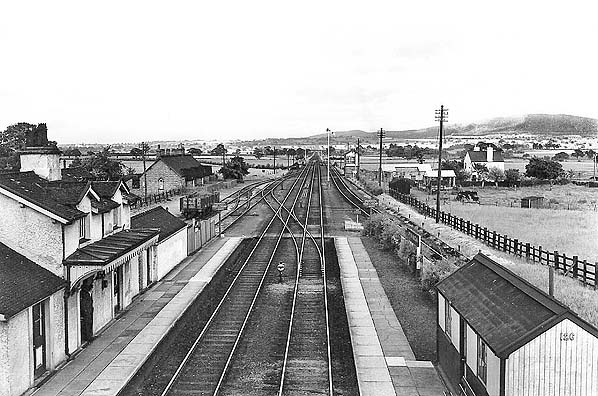
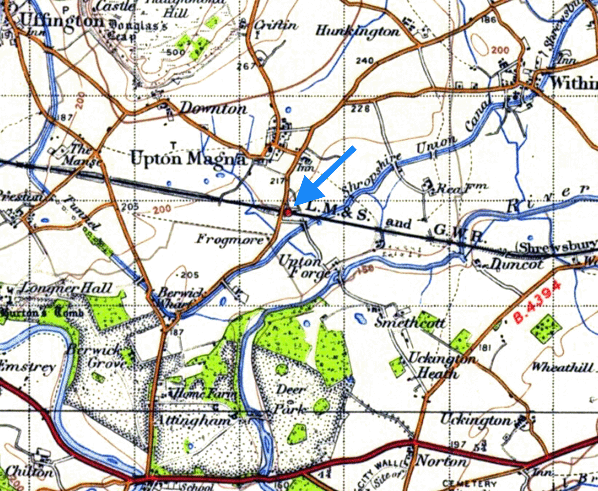
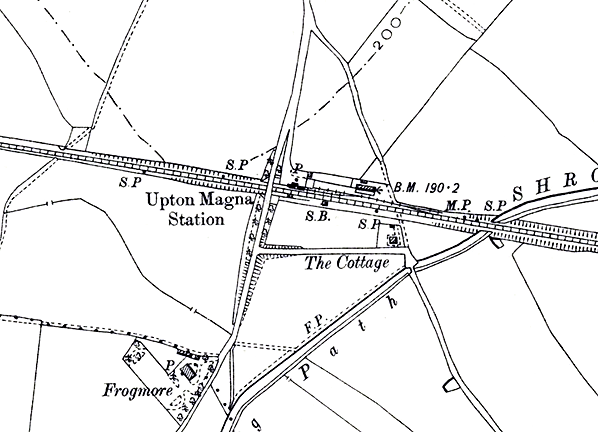
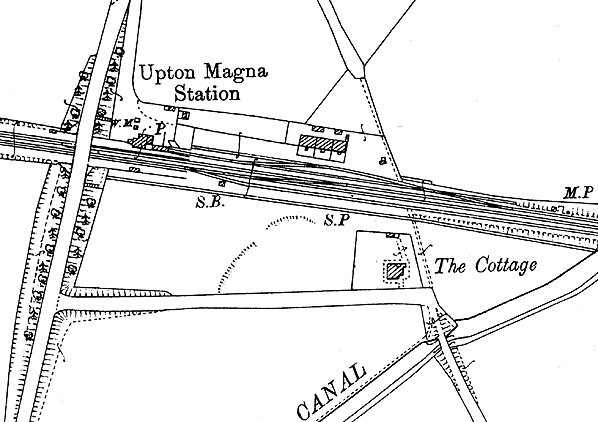
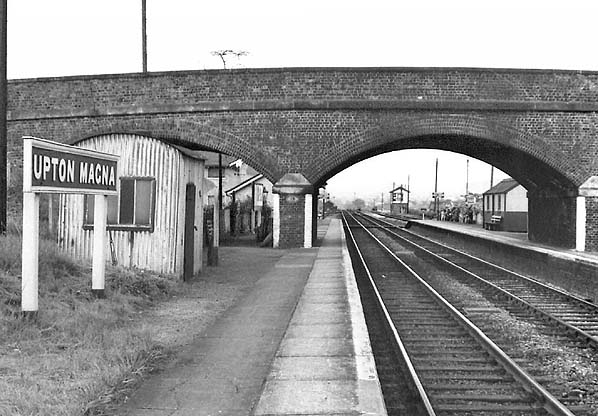
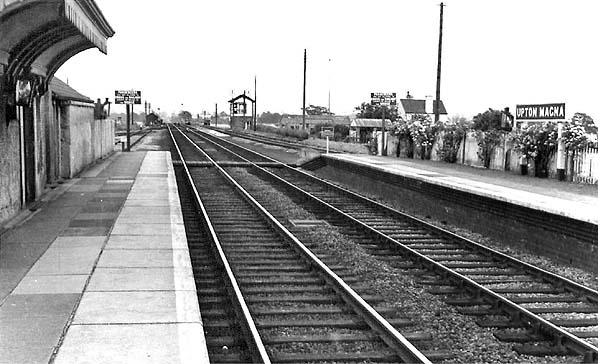

.gif) A few trains from Upton Magna had started to run through to Birmingham New Street on 4 February 1854 via an LNWR line but they moved to Birmingham Snow Hill on 13 November 1854 and the service was improved.
A few trains from Upton Magna had started to run through to Birmingham New Street on 4 February 1854 via an LNWR line but they moved to Birmingham Snow Hill on 13 November 1854 and the service was improved. gwpn).gif) In 1958 there were seven trains in each direction Monday-to-Friday. Six of the up services went to Stafford and one went to Birmingham Snow Hill. Six of the down services went to Shrewsbury five of them originating from Stafford. The other train went to Chester. On Saturdays there was an extra up train that departed for Wolverhampton Low Level at 10.18pm. In the down direction there were two extra trains both of which went to Shrewsbury.
In 1958 there were seven trains in each direction Monday-to-Friday. Six of the up services went to Stafford and one went to Birmingham Snow Hill. Six of the down services went to Shrewsbury five of them originating from Stafford. The other train went to Chester. On Saturdays there was an extra up train that departed for Wolverhampton Low Level at 10.18pm. In the down direction there were two extra trains both of which went to Shrewsbury. .gif) The goods sidings were lifted before the passenger station closed. After 7 September 1964 the rest of the station was swiftly demolished. The down goods loop and signal box closed on 21 May 1967.
The goods sidings were lifted before the passenger station closed. After 7 September 1964 the rest of the station was swiftly demolished. The down goods loop and signal box closed on 21 May 1967. 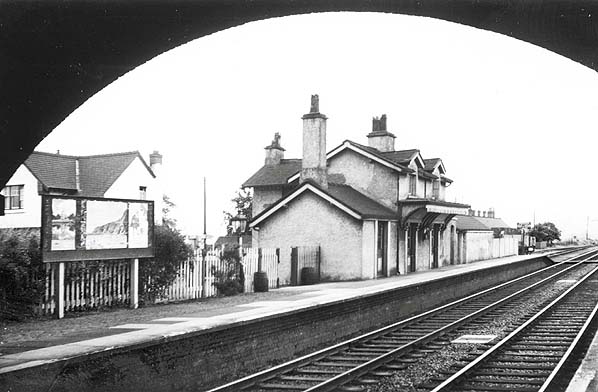
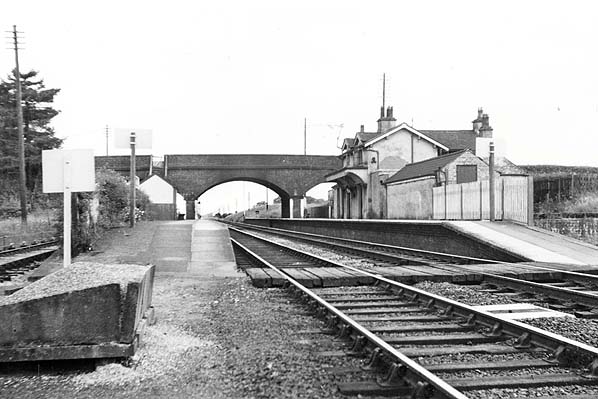
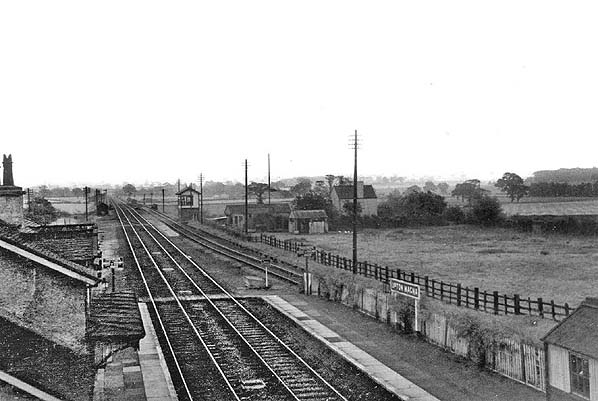
.jpg)

 Home Page
Home Page